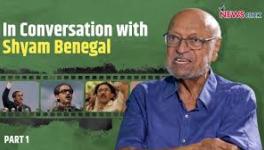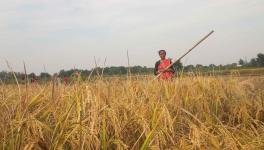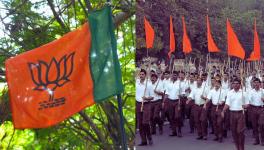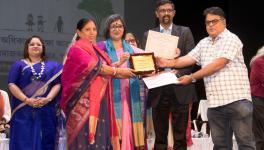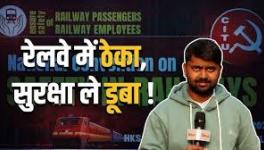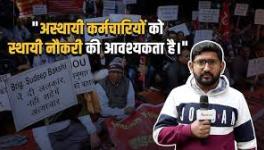RSS & Battle for Tribal, Kurmi Identity in Jangalmahal
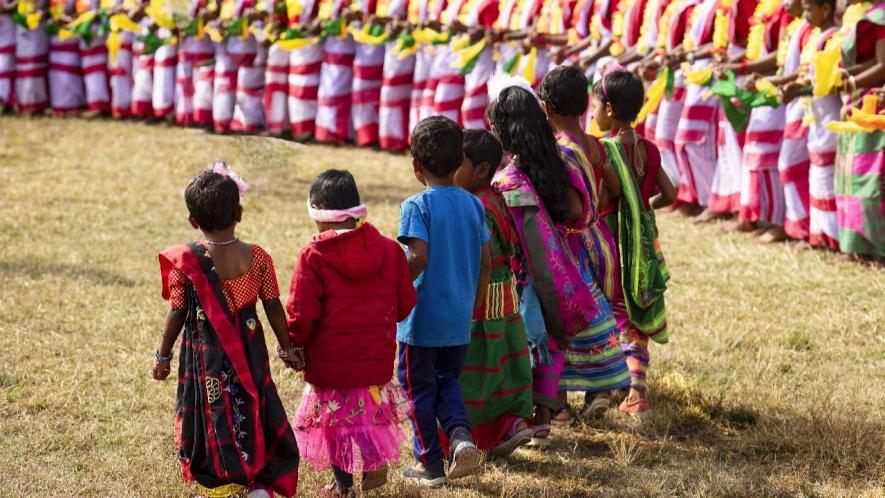
Tribal people performing their traditional culture in Susunia hill area of Jangalmahal, Bankura.
The Rashtriya Swayamsevak Sangh (RSS) continues its campaign in the Jangalmahal region of Bengal, employing various strategies to establish the narrative that all tribal communities are Hindus. This approach undermines the traditional identity and demands of tribal people, who have been historically identified as bonobasi (forest-dwellers). Similarly, despite having distinct religious practices, the Kurmi community is also being labelled as Hindus by the RSS.
The RSS campaign includes activities, such as reading scriptures like the Gita and the Ramayana, creating conflicts over reservation policies between communities, and promoting Hindutva ideologies among them. These efforts are being carried out through diverse means across the region.
The ruling Trinamool Congress (TMC) has largely remained silent on the matter, viewing it as a religious issue. In fact, many TMC leaders and activists are allegedly assisting the RSS in its efforts. Meanwhile, protests have erupted in various places as some communities recognise and resist this strategy.
However, despite the opposition, the influence of RSS's religious narrative continues to grow across Bankura, Purulia, and Jhargram, Pashchim Medinipur districts. The RSS net is steadily spreading, raising concerns among those who value the unique cultural identities of the tribal and Kurmi communities.
How Hinduism is Being Spread Among Tribals/Kurmis
The tribal and Kurmi communities inhabit a vast area of Bengal's Jangalmahal region, spanning the districts of Bankura, Purulia, Jhargram, and Paschim Medinipur. These communities, numbering lakhs, have lived in the dense forests and hilly terrain for centuries. Areas like Ranibandh, Raipur, Sarenga, Simlapal, and Hirbandh in Bankura; Bandowan, Barabazar, Manbazar, Balarampur, and Hura in Purulia; Belpahari, Banspahari, Nayagram, Lalgarh, and Jhargram in Jhargram; and Garbeta, Chandrakona Road in Paschim Medinipur are home to these communities.
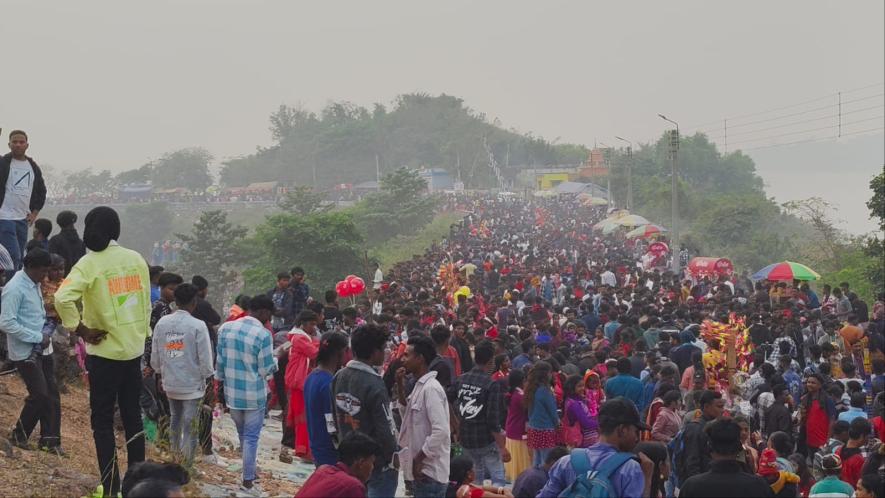
Makar sangkrani mela is one of the most popular festivals of jangalmahal area. All people including tribals, kurmis participate in this festival. Crowd in the pareshnath area of Mukutmonipur, Ranibandh on January 14.
Notably, 52% of the population in Purulia district comprises the Kurmi community, making them the majority in that area. Tribal communities form a significant majority in Ranibandh block of Bankura, as well as Belpahari and Lalgarh in Jhargram. Among the tribal population, the Santals constitute the largest group, alongside other tribes, such as the Bhumij (Sardar), Munda, Shabar, Mahali, Birhor, Pahariya, and Kora.
These tribal and Kurmi communities are traditionally nature worshippers. Their lives—birth, growth, and sustenance—are deeply intertwined with the forests and hills surrounding them. Nature is regarded as omnipotent, shaping their religious and cultural practices. They have their own distinct religions, languages, and traditions. However, the RSS refuses to acknowledge these unique cultural and religious identities, asserting instead that these communities are part of the broader Hindu religion.
"Tribals are part of the larger Hindu religion; they have merely forgotten this over the centuries. It is our responsibility to bring them back into the Hindu mainstream. The Kurmis, on the other hand, already participate in Hindu rituals and festivals. So, where is the problem in calling them Hindus? We are working toward that goal," a teacher of an RSS-run Saraswati Shishu Mandir school in Jhilimili, Ranibandh block, Bankura, told this reporter.
When asked if there was any historical evidence to support the claim that the indigenous tribal and Kurmi people were Hindus, the teacher, a resident of Ranibandh, stated unequivocally that written evidence was unnecessary, as it was simply a matter of faith. He emphasised that the RSS sought to shape the behaviour of these communities to “align with Hindu practices.”
Binoy Chakroborty, an RSS preacher from Binpur in Jhargram, when asked about pressing issues, such as unemployment, lack of healthcare, and the increasing number of school dropouts in Jangalmahal, dismissed those concerns and said, "Our focus is on bringing everyone into the fold of Hinduism. If we don't, society will deteriorate. It is not our concern to address people's livelihoods—that is the government's responsibility."
The RSS began its activities in eastern Bengal in 1949 by establishing its headquarters in the Gopali area of Kharagpur in undivided Medinipur district. Initially, they trained unemployed and marginalised youths under the pretext of “rebuilding society”, in a bid to gain traction in the Jangalmahal region. However, due extreme poverty in the area, such religious sentiments failed to resonate. The RSS opened a few shakhas (training camps), but their activities remained limited.
The situation changed drastically after the Left Front came to power in West Bengal in 1977. Under the LF government, the state administration actively curbed attempts at caste and religious polarisation, significantly diminishing RSS activities. According to Pulinbihari Baske, state secretary of the Paschimbanga Adivasi Adhikar Mancha, "The RSS's influence waned during that period. The State did not allow their divisive agenda to take root."
Former Backward Classes Welfare Minister of Bengal, Upen Kisku, a resident of Raipur, and Sahadeb Mahato, a former Sabhapati (block chief) of Ranibandh, recalled how the LF government prioritised poverty alleviation in Jangalmahal post-1977. Land was distributed among poor tribal and non-tribal communities for cultivation, schools and hospitals were established, and people were actively involved in developmental activities. This significantly diminished RSS influence, and the situation persisted until 2011, when TMC came to power.
“In the mid-1990s, the RSS established a few primary schools in the Jangalmahal region. However, they failed to make an impact among the impoverished tribal, Kurmi, and other communities,” said Pranab Hazra, librarian at Sidho Kanho University in Purulia.
After the TMC came to power in the state in 2011, the scenario in Jangalmahal area began to change. Several schools were established under the management of the Bidyabikas Parishad of RSS in the forested areas of Bankura, Purulia, Jhargram, and Paschim Medinipur.
Within a few years, people lost faith in government educational institutions due to several reasons, including a lack of required teachers and the cessation of regular infrastructure renovation. The RSS capitalised on this vacuum. Many tribal and non-tribal families began sending their sons and daughters to these schools, paying monthly tuition fees. Some of these schools were named Saraswati, Ma Sarada, Ramkrishna, Swami Abhayananda, and Bonobasi Kalyan Chhatrabas.
In addition to the schools, new RSS training camps were initiated in various locations. Activities like stick and knife games were taught at these camps. One of the primary objectives of these training camps was to spread a narrative of Hindutva and, at times, foster animosity toward other religions.
Saraswati Shishu Mondir school in Jangalmahal Khatra run by RSS.
“After the BJP (Bharatiya Janata Party) came to power at the Centre in 2014, the activities of RSS increased across Jangalmahal. Efforts were made to attract unemployed tribal youth, especially from the Santal and Bhumij communities, as these two communities form the majority among the tribals in Jangalmahal,” said Lakhman Mandal, a primary school teacher from Ranibandh.
Mandal noted that in schools where tribal boys and girls were the majority, local tribal youths were appointed as teachers. However, these teachers were given only nominal remuneration, a strategic move aimed at gaining acceptance among the local population. Similarly, in schools situated in Kurmi-dominated areas, Kurmi teachers were appointed.
According to several residents across these four districts, the RSS primarily uses its schools to further its agenda. Accredited Social Health Activist (ASHA) worker Malati Hemram from the Barikul area of Ranibandh, Tapan Mahato from Lodhasuli village in Jhargram, and Manorath Mahato from the Manbazar area of Purulia District observed that teachers from these schools regularly visited students’ homes and engaged with parents. These interactions went beyond discussions on improving students’ academics and often included conversations about Hindutva. Parents were compelled to listen and were often influenced by these discussions.
“In this Jangalmahal area, people from tribal and non-tribal communities have coexisted harmoniously for centuries. The region is vibrant with festivities throughout the year, with everyone participating in each other’s celebrations. Despite this, the tribals have always retained their distinct religion,” said Mohan Hembram, a tribal folk artist from Barikul, Ranibandh. Digonto Hembram, a resident of Belpahari, Jhargram, stated, “We do not believe in idol worship. We are not Hindus. If Hinduism is imposed on us by force, it will not be tolerated.”
The fact remains that the religion of Santal tribals is Sari and Sarna, while the Shabar people follow Khaddiya. Other tribal communities, such as Munda, Bhumij, Pahariya, Mahali, and Birhar adhere to Sarna Dharma. Notably, all of them believe that nature is the ultimate source of energy. Each community has its own language and festivals. Similarly, the Kurmi people have their own religion, Sarna, and their language is Kurmali. However, the RSS does not acknowledge these distinct identities.
“The national Census records the religion of individuals. With the next Census approaching, if the tribals and Kurmis mention their actual religion, the number of Hindus in the country could decrease by about 20 crore,” stated an RSS preacher, who is also an engineer from Raipur, Bankura. He added that in the 2011 Census, tribals and Kurmis were identified as Hindus, and the RSS does not want the Hindu population to decline. Librarian Pranab Hazra remarked that this was one of the main reasons why RSS has insisted on labelling tribals as “Hindu” while disregarding their unique religions.
The RSS has also been campaigning to exclude tribals who have converted to Christianity from the ambit of tribal reservation. This claim has been echoed by locals, such as Jayoti Murmu and Goutam Hansda, along with several residents of Sarenga, Bankura. Many of them report being pressured to return to Hinduism in various subtle and overt ways.
To foster an atmosphere of Hindutva, the RSS frequently organises evening reading sessions of the Gita and Ramayana under banners such as Ramkrishna Seba Niketan, Vivekananda Seba Niketan, Bonobasi Kalyan Ashram, and others. These sessions are often led by respected figures from the Santal community in areas with a significant Santal population.
Similarly, in Bhumij and Kurmi-dominated regions, individuals from these communities are engaged to conduct such readings. This practice has been observed in places like Haludkanali in Raipur, Jhilimili, Birkham, and Rutra in Ranibandh, Bankura; Binpur and Lalgarh in Jhargram; Bandowan, Barabazar, and Balarampur in Purulia; and Garbeta and Salboni in Paschim Medinipur.
Sub-Divisional Officer (SDO) of Khatra, Bankura, Subham Mourya, stated that the administration was aware of these religious ceremonies in areas like Raipur, Ranibandh, Sarenga, and Hirbandh blocks, and an inquiry was underway.
Interestingly, some leaders and activists of the ruling TMC are reportedly participating in these events, either openly or discreetly.
Meanwhile, the TMC government is creating religious worship spaces like Jaherthans and Goramthans for tribals and Kurmis. However, many residents of Jangalmahal are raising concerns about the region's deteriorating socio-economic conditions. Once a major source of livelihood was the collection and sale of Kendupata (used in making bidis), under the government-supported Large Size Multipurpose Adivasi Cooperative Society (LAMPS), ceased after the TMC came to power. Additionally, MGNREGA ( the rural job guarantee scheme) work in the area has been suspended for the past three years.
As a result, school dropout rates have risen significantly. Many students are abandoning their education and migrating to other states for work. Locals allege that the TMC government is attempting to divert attention from these pressing issues by organising events like the Joyjohar Mela and other entertainment programs, rather than creating meaningful job opportunities.
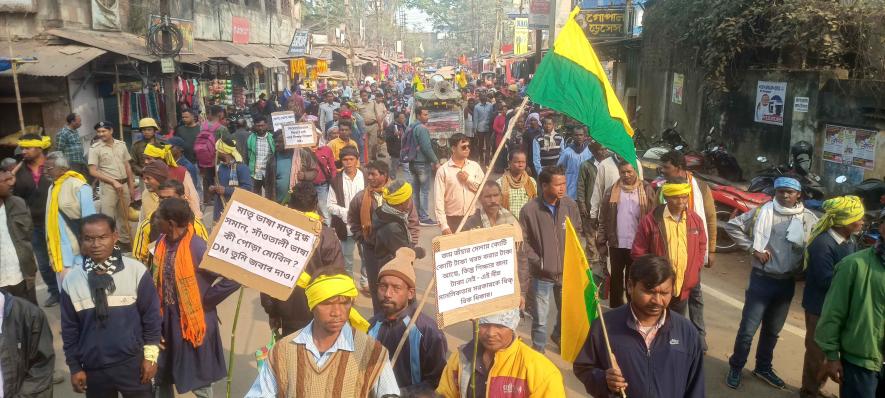
On January 7, tribal people gathered in Bankura, submitting a deputation to Bankura District Magistrate demanding work, education, health structure development in Jangalmahal. They do not want Joyjohar mela.
"Is Jangalmahal being treated like a guinea pig?" many people ask.
Frustration has boiled over into protests. On January 7, tribal communities across Bankura district gathered before the District Magistrate's office, demanding action. Leaders like Baidyanath Hansda and Bhim Chandra Murmu of the Bharat Jakat Majhi Parganamahal urged the administration to reopen closed school hostels, recruit teachers transparently to fill up vacancies, ensure the return of students and create employment opportunities for the people of Jangalmahal.
The writer covers the Jangalmahal region for ‘Ganashakti’ newspaper in West Bengal. The views are personal.
(All pictures by Madhu Sudan Chatterjee)
Get the latest reports & analysis with people's perspective on Protests, movements & deep analytical videos, discussions of the current affairs in your Telegram app. Subscribe to NewsClick's Telegram channel & get Real-Time updates on stories, as they get published on our website.











